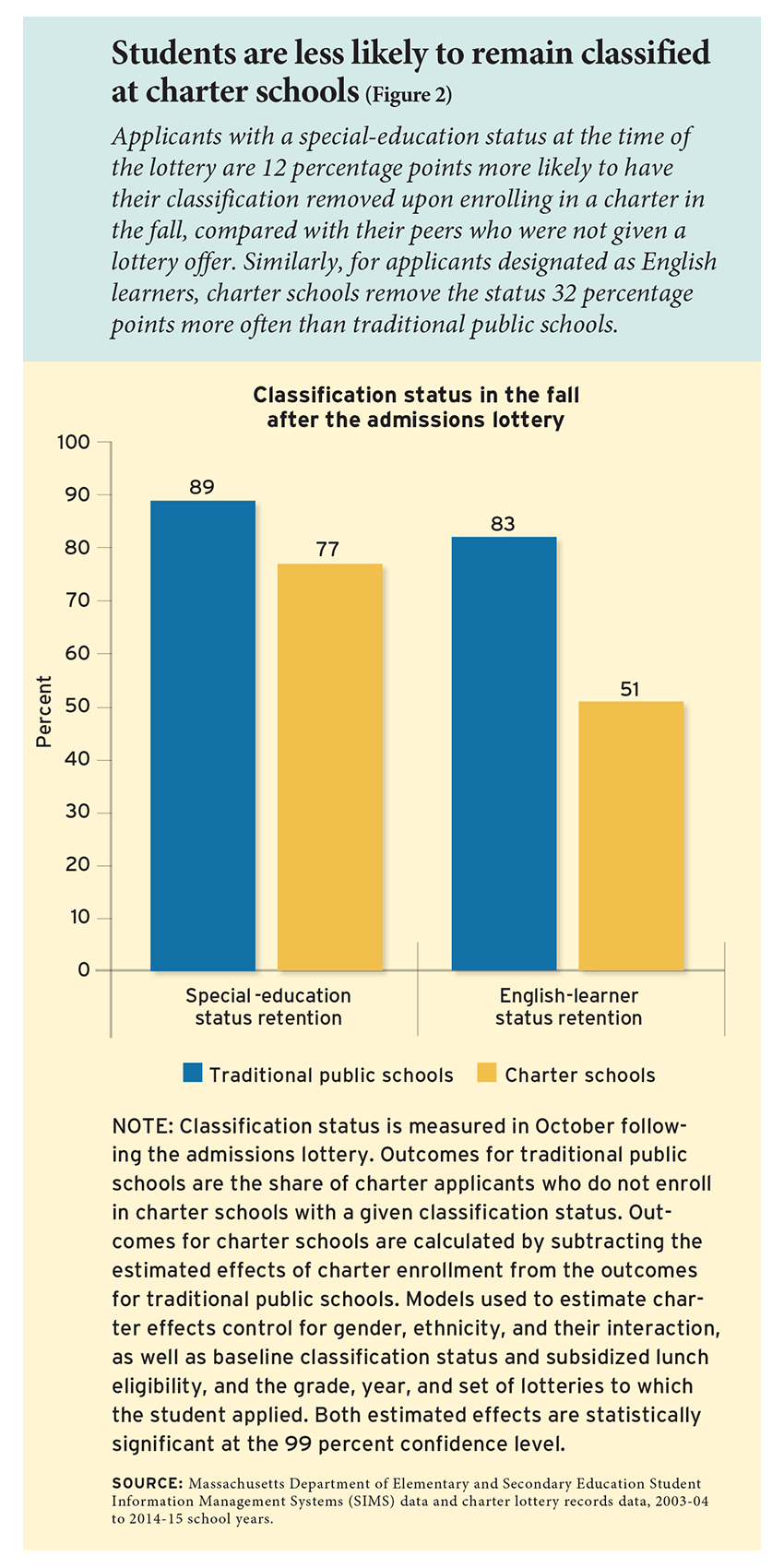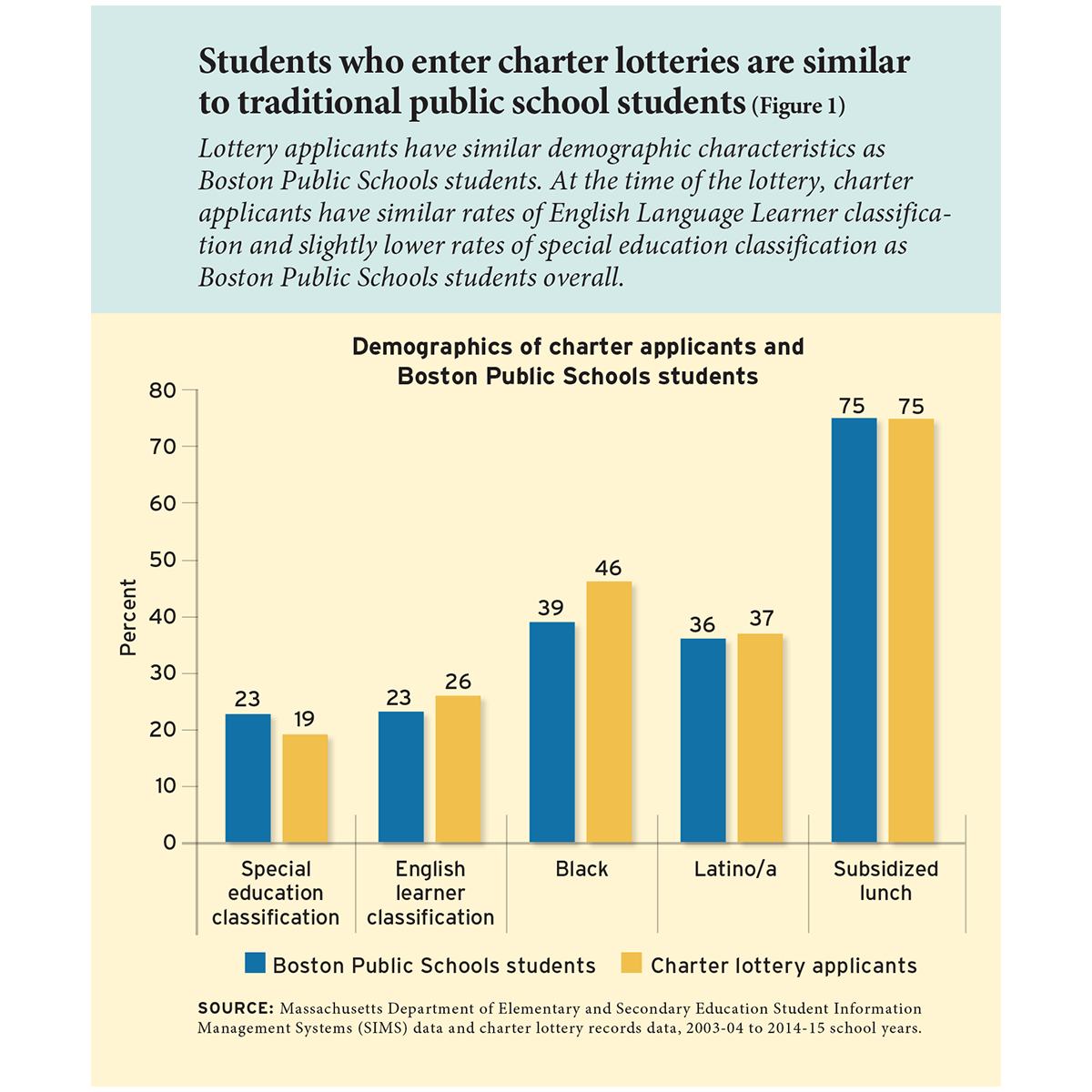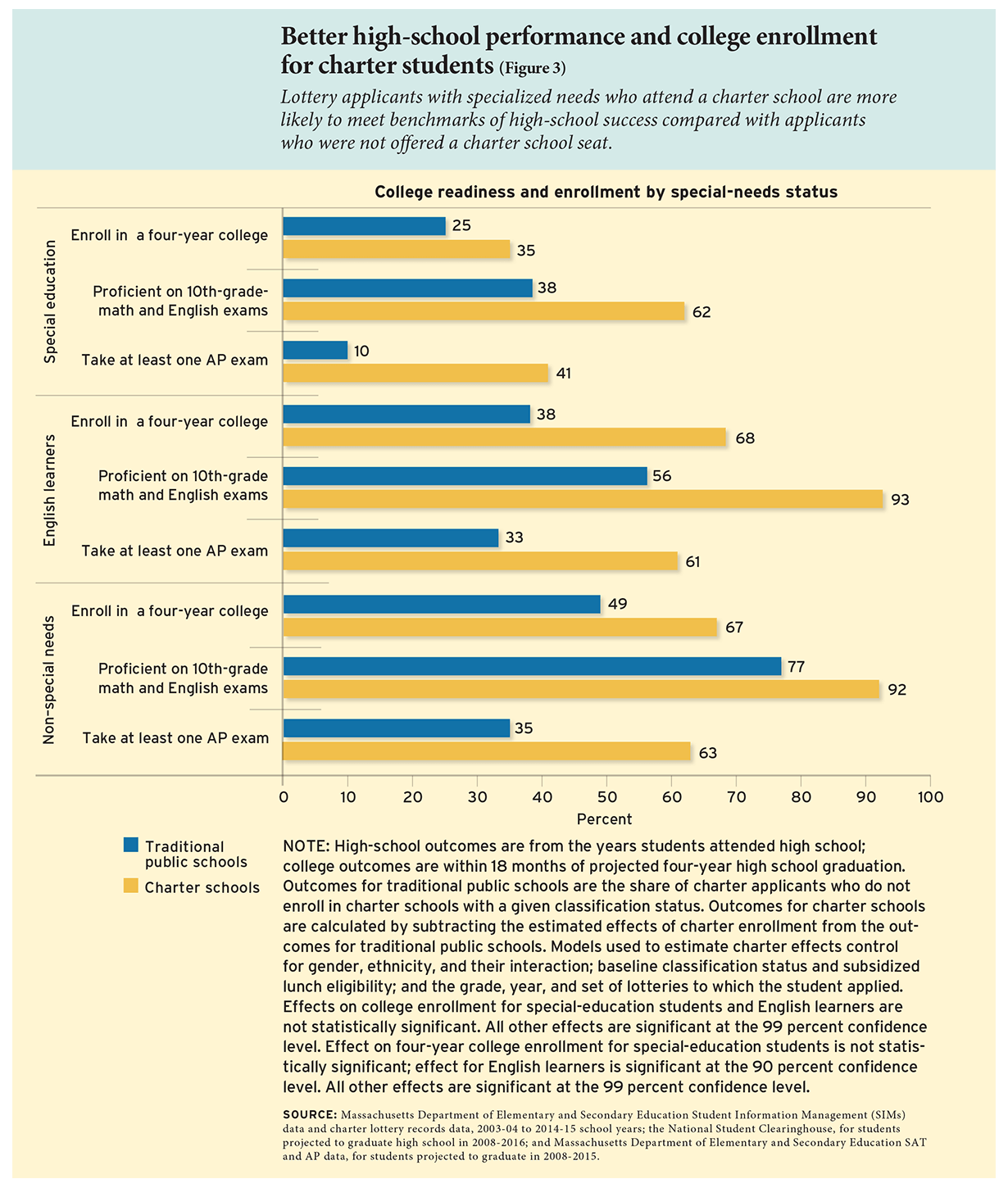
by Elizabeth Setren
Maximizing the potential of all students is the stated goal of many schools. When some students have specialized needs, however, the best way forward isn’t always clear.
Consider students whose unique learning needs entitle them to special-education services or those who are English language learners. Schools invest significant time, resources, and attention in serving these populations, and federal and state governments pay for targeted services for these groups. This funding design assumes that additional education spending for special-education students and English learners should be focused on specific supports for only those students, such as specially trained teachers, curriculum, and counselors, instead of balanced between specialized supports and more general investments in overall school quality. Is that the most effective approach?
Nationwide, special-education students and English learners account for a significant share of total enrollment: federal data from 2016 show 14 percent of all students receive special-education services, and nearly 10 percent are English learners. Those shares are even larger in most U.S. cities, which tend to include large numbers of new immigrants and other students with specialized needs. Those students experience major gaps in achievement compared to their typical peers; on the most recent reading test of the National Assessment of Educational Progress, for example, just 12 percent of special-education students and 9 percent of English learners scored proficient, compared to 38 percent of students without those classifications. Students with specialized needs exist in significant numbers and generally show low levels of academic achievement. Little causal evidence exists for how to improve the educational trajectories of these students.
To understand the tradeoffs between investments in targeted supports versus investments in overall school quality, I look at public schools in Boston, where about 50 percent of students are classified as either special education or English learners and 17 percent of students attend charter schools. Boston charter schools spend 44 percent less on special-education services per student than traditional public schools do but implement education practices that positively affect all students, such as data-driven instruction, high academic expectations, increased instructional time, and intensive tutoring. The city’s mix of school types presents a unique opportunity to look at how reduced access to targeted services and exposure to high-quality general-education practices affect the achievement of students with specialized needs, because students who apply to charter schools are admitted by lotteries and therefore randomly assigned to one of the two models.
I find that charter enrollment at least doubles the likelihood that a student designated as special education or an English learner at the time of the admissions lottery loses this classification and, subsequently, access to specialized services. Yet charter enrollment also generates large achievement gains for students classified at the time of the lottery—similar to the gains made by their general-education charter classmates.
Classified students who enroll in charters are far more likely to meet a key high-school graduation requirement, become eligible for a state merit scholarship, and take an AP exam, for example. Students classified as special education at the time of the lottery are more than twice as likely to score 1200 or higher on the SAT than their counterparts at traditional public schools. English learners who enroll in charters are twice as likely to enroll in a four-year college.
I investigate what explains these academic gains and find suggestive evidence that removing classifications has a small positive effect on student test performance. The academic gains appear to be driven not by the classification change but instead by the general-education practices implemented at charter schools.
To be sure, targeted services for students with specialized needs can make a major difference in helping overcome specific barriers to learning. But my findings highlight the importance of the overall school environment as well. Combined, the findings show that it is feasible for many students with specialized needs to make large academic gains in a high-quality general-education program without access to specialized services. Districts and schools deciding how to invest their resources may find that an increased focus on overall school quality can improve outcomes for all.
Background
The special-education classification process begins when a parent, teacher, or school staff member requests that a student be evaluated by learning specialists or other experts to set individualized learning goals and determine which supports are needed to achieve them. If the student is entitled to specialized services, school staff must develop an Individualized Education Program that details the supports the student will receive. Special-education students with a wide variety of needs are given a broad array of services in general and specialized settings. These services may include preferential seating and extra time on tests in regular-education classrooms and participation in separate classrooms for students with disabilities. Schools are
required to re-evaluate students’ classification and level of services every three years.
Classification for English learners is different; while federal law provides a common definition, it’s up to states to determine how to identify eligible students. In Massachusetts, public schools survey parents of new students to identify those whose primary language at home is not English. Once identified, these students take an English proficiency exam, and based on the results, a licensed teacher or administrator awards the classification and determines what services the student will receive. English learners are re-assessed each year, with the goal of achieving fluency and no longer qualifying for extra support. By contrast, the goal of special-education plans is not obsolescence but for the student to reach individualized benchmarks in academic and life skills.
The financial and accountability incentives for these classifications work in opposite directions and affect charters more than they do traditional public schools. The school funding formula in Massachusetts does not include special-education enrollment in an effort to discourage over-classification. For the same reason, federal special-education grants do not consider the number of classified students. For English learners, the state distributes federal funding to pay for specialized services, but it is not always sufficient. A Massachusetts state court in 2015 found the state formula did not provide enough funding to meet the costs of educating English learners and recommended an additional $2,361 for each student, for example. Smaller school districts and charter schools face larger disincentives for classifying students; without the benefit of economies of scale, it is more challenging for small schools to provide specialized services.
Accountability measures encourage schools to classify students properly regardless of the financial implications. Massachusetts inspects how schools identify and serve special-education students and English learners, and its accountability system considers the outcomes of these groups in addition to overall student performance. In addition, charter schools must undergo a rigorous review process by the state every three to five years in order to retain their charter, so these incentives may affect them more acutely than they do traditional public schools.
There are other relevant differences between district and charter schools in Boston. District schools have more experienced, more licensed, and higher-paid teachers and spend about $1,700 more per pupil relative to local charter schools. However, educational practices are markedly different in the charter sector. More than half of Boston charters have a longer school year and more than 95 percent have a longer school day compared to traditional district schools. Tutoring programs exist in all Boston charters, and about one third require tutoring for all students. Boston charters also commonly use practices that include setting high academic and behavior expectations, selective teacher hiring, frequent testing and teacher feedback, and data-driven instruction. Prior research has shown that this mix of practices has a strong positive relationship with charter effectiveness and yields positive effects when implemented in traditional public schools or schools converted to a charter model. However, little is known about the effect of these practices or charter schools on special-education students and English learners specifically.
Who applies to charter schools?
To study the effect of charter attendance on outcomes for students classified as special education or English learners, I look at comprehensive state education data for about 18,000 students who participated in the admissions lotteries of 30 charter elementary, middle, and high schools in Boston from the 2003–04 to 2014‒15 school years. Altogether, these schools account for the vast majority of the city’s charter sector—approximately 90 percent of enrollment in 2012‒13.
I focus on students who were classified as either special education or English learners at the time of the admissions lottery, as a student’s needs and status can change over time. For special-education students, I look at students’ special-education status, disability type, and level of classroom inclusion. For English learners, I look at students’ status, native language, and test scores on the annual English proficiency exam. I categorize students’ English proficiency as beginning, intermediate, or advanced based on their exam scores and the state guidelines for services.
Special-education students and English learners were well represented in the Boston charter-school lotteries (see Figure 1). About 19 percent of lottery applicants had a special-education status at the time they applied compared to 23 percent of Boston students overall. Similarly, about 26 percent of lottery applicants were classified as English learners compared to 23 percent of Boston students overall. On average, charter applicants had slightly higher test scores compared to Boston students overall. Applicants and non-applicants also had broadly similar demographic characteristics. These similarities hold true when looking at the overall applicant pool as well as when looking solely at special-education students and English learners.
The students who apply to charters represented a range of needs. Special-education students from substantially separate classrooms were slightly underrepresented in Boston charter lotteries, while students from partial-inclusion classrooms were slightly overrepresented. English learners of all levels of proficiency were more prevalent in charter lotteries than in Boston Public Schools overall.
For students who receive an offer to enroll, going to a charter school has two major effects: first, an increased likelihood of having their specialized classification removed, and second, exposure to the charter school environment. These could have complementary or opposing impacts. The high academic and strict behavior standards common at Boston charters could leave these students behind, or the students could meet the higher expectations. In addition, students could thrive in a more inclusive classroom environment or fall behind without the specialized services they previously received.
Below, I examine how charter enrollment affects rates of classification, and how charter attendance affects the academic outcomes of students classified as needing specialized services at the time of the admissions lottery. To the best of my knowledge, no prior causal evidence exists for special-education classification removal.
Effects on classification
 Students designated as special education at the time of the charter admissions lottery are far more likely to lose that status and be placed in a more inclusive classroom if they enroll at a charter school than if they enroll at a traditional public school. Similarly, English learners are also far less likely to be classified as such when they enter a charter school compared to attending a traditional public school. Both classification rate changes reflect differences in how charter schools categorize students, not gains in learning.
Students designated as special education at the time of the charter admissions lottery are far more likely to lose that status and be placed in a more inclusive classroom if they enroll at a charter school than if they enroll at a traditional public school. Similarly, English learners are also far less likely to be classified as such when they enter a charter school compared to attending a traditional public school. Both classification rate changes reflect differences in how charter schools categorize students, not gains in learning.
Students with a special-education status at the time of the lottery are 12 percentage points more likely to have their classification removed upon enrolling in a charter; in the fall after the admissions lottery, 77 percent of students at charters retain their special-education status compared to 89 percent of students at traditional public schools (see Figure 2). This includes students with more severe disabilities: applicants who had been educated in substantially separate classrooms the prior year are 17 percentage points less likely to keep their special-education status upon enrolling in a charter school compared to at a traditional public school. Among students new to the district (who therefore were not yet evaluated for specialized needs), close to zero are classified as special-education students at charters compared to 1.4 percent at traditional public schools.
Charters also move students who were classified as special education at the time of the lottery to more inclusive classrooms more often than traditional public schools do, giving students more time in general-education settings and less time receiving services outside of mainstream classrooms. Across all ranges of need, students who enroll at a charter school are 27 percentage points more likely to be educated in inclusive classrooms than are students at traditional public schools. Special-education students from substantially separate classrooms are 38 percentage points more likely to be placed in more inclusive classrooms or to have their classification removed entirely. The classification and inclusion effects are consistent across grade levels and persist for two years.
For students designated as English learners at the time of the lottery, charters remove that status 32 percentage points more often than traditional public schools do; in the fall after the admissions lottery, 51 percent of students at charters retain their classification compared to 83 percent at traditional public schools. Most of that difference is in shifts in status among students with intermediate and advanced English proficiency; those with beginning English proficiency rarely have their classification removed at the time of enrollment. Overall, traditional public schools designate 64 percent of non-native English speakers as English learners, compared to 38 percent of non-native English speakers classified in charter schools.
These shifts occur in different ways. Individual schools determine English learner status for their students, based on how they interpret student performance on the English proficiency exam. Therefore, lower classification rates at charters likely reflect different preferences and interpretations of the exam. However, Massachusetts, which mandates screening of incoming students for English learner status, does not require schools to assess all newly enrolled students for special-education needs. Rather, the speed and fidelity with which student records are transferred between traditional district and charter schools likely plays a major role in special-education classification changes.
Most charters learn of student classifications from voluntary parental reporting before school records are received, and some families may choose not to disclose a child’s special-education status. A survey conducted by the Massachusetts Department of Elementary and Secondary Education as a result of this analysis found that the most common reason for classification removal was parents declining to report a designation. Possible reasons parents might decline to report include fear of stigma, not agreeing with or wanting the designation, not knowing that they should notify the school, and not understanding their child’s status or entitlements. In addition, charter schools’ preference for high levels of inclusion for special-education students, often cited in their publicly available annual reports, likely also contributes to these changes.
Effects on academic performance
Once students enroll, charter school attendance has large positive effects on a host of educational outcomes, from test scores to enrollment in college.
After a year at a charter school, students who were designated as English learners or special-education students at the time of the admissions lottery do far better on state tests: their scores increase by 0.26 standard deviations in math and 0.21 in reading. English learners’ scores increase by 0.33 standard deviations in math and by 0.24 in reading. As a result, one year of charter attendance narrows the achievement gap between English learners and their typical, non-classified counterparts in Boston Public Schools by 84 percent in math and 39 percent in reading. For special-education students, charter enrollment decreases the achievement gap by 30 percent in math and 20 percent in reading. The gains continue through the second year at a similar rate: in math, the effect nearly doubles for special-education students and grows by 1.6 times for English learners. In the third year, the effects stabilize and students maintain their progress, but their rate of growth that year is comparable to students in traditional public schools.
The annual English proficiency exam—which schools use to re-evaluate English learners’ classification and services—also suggests that charter schools improve non-native speakers’ English skills. Students at charter schools perform similarly or significantly better compared to district school students, even though only those students with very limited English skills tend to keep the classification that requires they take the proficiency exam after enrolling. In all, charter students are 28 percentage points less likely to take the proficiency exam. Those charter students who do take the test perform about the same as students at district schools.
Charters also have positive effects on longer-term educational outcomes (see Figure 3). Students are more likely to reach proficiency on 10th-grade math and reading exams, a state graduation requirement, with an increase of 24 percentage points in the likeliness of passing the tests for special-education students and an increase of 37 percentage points for English learners. They are more likely to take at least one Advanced Placement class, with increases of 31 percentage points for special-education students and 28 percentage points for English learners. Charters also boost the likelihood that students will become eligible for a state-run merit college scholarship program awarded based on 10th-grade state test scores by 11 percentage points for special-education students and 29 percentage points for English learners. In addition, charter attendance nearly doubles the likelihood that students designated as English learners at the time of the lottery enroll in a four-year college. The estimated effect of charter attendance on college enrollment for special-education students is also positive, but falls short of statistical significance.
However, charter enrollment lowers students’ likelihood of graduating high school within four years by 30 percentage points for special-education students and 18 percentage points for English learners. This is surprising given the gains in reaching the proficiency graduation requirement, though prior research suggests that students could take longer to graduate from charters because they need additional time to meet rigorous graduation requirements or choose to save money by remaining in high school for an additional year rather than taking remedial course work in college. There is no significant difference between the five-year graduation rates at charter and traditional district schools, in support of this theory. Most students classified as special education or English learners at the time of the charter lottery who do not graduate high school in five years appear to transfer to other schools rather than dropping out. Because certain high-need special-education students qualify for transitional education and support services through their 21st year if they remain enrolled in school, this could be a positive trend.
The impact of inclusion
Students with specialized needs who enroll in charters attend schools with markedly different characteristics than those who apply and do not receive lottery offers, and those differences are correlated with positive effects on test scores. Do these academic gains stem from those general charter-school characteristics that affect all attendees? Or do they stem from the removal of specialized classifications and increased inclusion that students experience at charter schools? Legal requirements and best practices operate under the assumption that designated students require specialized and often separate services and accommodations to succeed. But could classification removal and increased inclusion actually help some special-education students and English learners succeed?
To explore these questions, I look separately at the cohorts of students designated as special education and English learners who applied to each charter school in each year. I then examine whether the schools that re-classified more of these students and, in the case of special-education students, increased their inclusion, produced stronger or weaker effects on test scores. This analysis provides no evidence that re-classification has negative effects on students’ academic progress, while also suggesting that it is the general charter-school environment that drives the bulk of the gains.
Among both special-education students and English learners, groups of charter-school applicants with higher rates of re-classification experienced modestly larger gains in test scores. These test-score effects also have a weak positive relationship with increased inclusion of special-education students.
The nature of these correlations—weak but positive—suggests that classification removal and increased inclusion contribute positively to student growth but cannot fully explain charters’ test-score gains. Therefore, other school practices, such as high expectations, data-driven instruction, more instructional time, and high-intensity tutoring, play an important role.
Conclusion
Critics argue that charter schools underserve special-education students and English learners because they enroll fewer of these students and might lack the economies of scale to provide separate classrooms and other intensive resources. At first glance, these criticisms would seem to apply in Boston. A look at the charter enrollment numbers shows lower representation of special-education students and English learners overall, and particularly among those with higher levels of need. However, my research reveals that students with these classifications apply to Boston charter schools at similar rates, but their status and level of inclusion are more likely to change in charters—giving the appearance that the Boston charters do not serve these students. It would be a mistake to infer from these statistics that charter schools are doing a poor job of serving students with special needs.
This analysis shows that charter schools that accelerate achievement among general-education students can also do so for students classified as special education or English learners. More generally, it demonstrates that schools can boost the academic outcomes of special-needs students without traditional specialized services. Since the study has nearly full coverage of an entire city’s charter sector across all grade levels, it overcomes a common criticism that lottery-based charter-school studies are flawed because the set of schools that elect to share data might differ from the rest of a city’s charters.
Enrolling in a Boston charter school amounts to a dual treatment for classified students: first, their classifications are removed at a higher rate than at traditional public schools and they join more inclusive classrooms, and second, they are exposed to a charter environment featuring practices like increased instructional time, high expectations, and data-driven instruction. These practices are positively correlated with overall charter-school effectiveness as well as charter effectiveness at serving special-education and English-learner students. The frequent use of tutoring, for example, enables charters to identify and provide support to any struggling student, regardless of their status.
As a result, both special-education students and English learners experience substantial gains on standardized exams in math and English, English proficiency, and college preparation and enrollment. Attending a charter school substantially decreases gaps in achievement between these students and typical students in Boston’s traditional public schools. Further, I find no evidence that removing students’ classification or increasing their inclusion in typical classrooms decreases outcomes.
More research is needed to determine whether these positive effects are specific to Boston, where the charter sector is especially high-performing. But the finding that special-education students and English learners can make large academic gains without specialized services in a high-quality general-education program calls for greater attention to overall school practices anywhere, in addition to the current focus on specialized supports, to improve outcomes for all.
Elizabeth Setren is the Gunnar Myrdal Assistant Professor of Economics at Tufts University.





